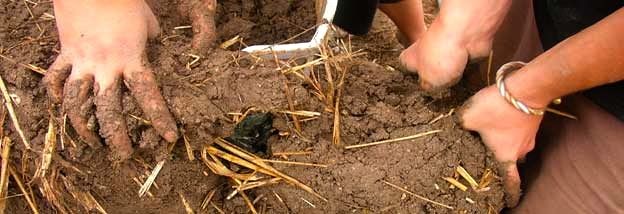Frequently Asked Questions
Natural plasters
What are your natural plasters made of?
We’ve developed our own mixes of a variety of common, natural, low embodied energy plaster materials. Some of the more common materials we use in our recipes include clay, lime, flour, marble dust, sand, chopped straw and (of course) clean, fresh water. Finish coats can also be tinted with natural tints and/or painted with natural silicate mineral paints.
All of the materials we use are solvent-free and non-off gassing.
Are natural plasters waterproof?
Natural plasters come in a wide range of water resistance ratings, but only a rare form of lime plaster from Morocco known as Tadelakt can be considered waterproof. Through good design, one of the more common (water resistant) natural plasters such as silicate paint or lime is all that is normally required; however, Fermata is proud to have one of the rare North American plaster crews who can offer a local version of Tadelakt as a finish option as well.
How long will they last?
Depending on the location, the quality of the design and the chosen finish, natural plasters can last a very, very long time. Some of the earliest known examples of lime plasters can still be seen at the tops of some Egyptian pyramids.
Maintenance?
Again, depends on location, design and finish. In the worst-case scenario (earthen/clay finish at the base of an exterior wall), plaster may need annual maintenance. For most people this is a “labour of love”. Until it isn’t, in which case they apply a more weather-resistant finish such as clay-lime or lime which is “self-healing” and thus requires very little maintenance.
How does your ecological footprint compare to artificial plasters?
Compared to conventional Portland cement-based mortar materials, any of our natural plasters are produced much more locally and with and lower embodied-energy. Compare any of our natural plasters to the more modern acrylic-based synthetic stucco systems, which are comprised mostly of petroleum bi-products and are shipped across the country, and our ecological footprint is even tinier in comparison
Cob
What are the base required materials?
Are pests a concern?
Insulative?
Will it do well in any climate?
How durable is it? Typical lifespan?
Can it crack?
How custom can the material be shaped? Can it be used for more linear/less organic shapes?
Adobe floors
Finish options?
Waterproof? Will it do well in the event of a flood?
Durable? Will it withstand impact?
Will it work for any room in the house? Bathroom/kitchen etc.
How does it feel? Coarse? Slippery? CAN ONE SLIP ON IT!?
Will the floors be warm/cold?
Earthen ovens
What materials are required?
Are they more ecological than a propane or coal barbecue?
How clean do they burn?
Can the temperature be monitored?
Can they be used for all conventional oven baking purposes? Cakes/bread/casseroles etc.
How well can they withstand the elements?
Can they be built indoors?
How big or small can they be?

